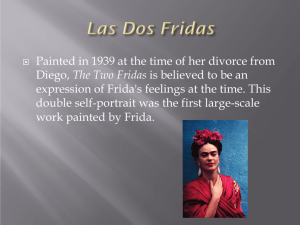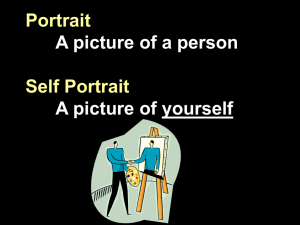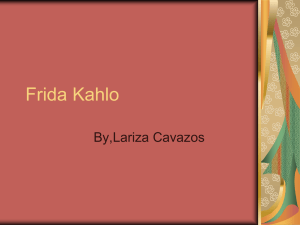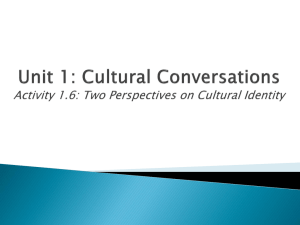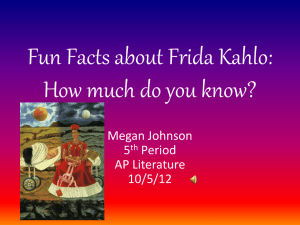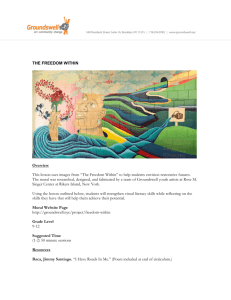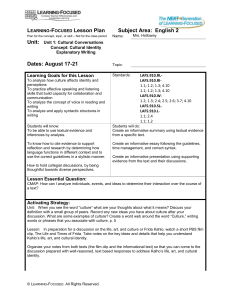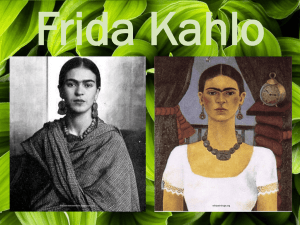The Life and Times of Frida Kahlo
advertisement
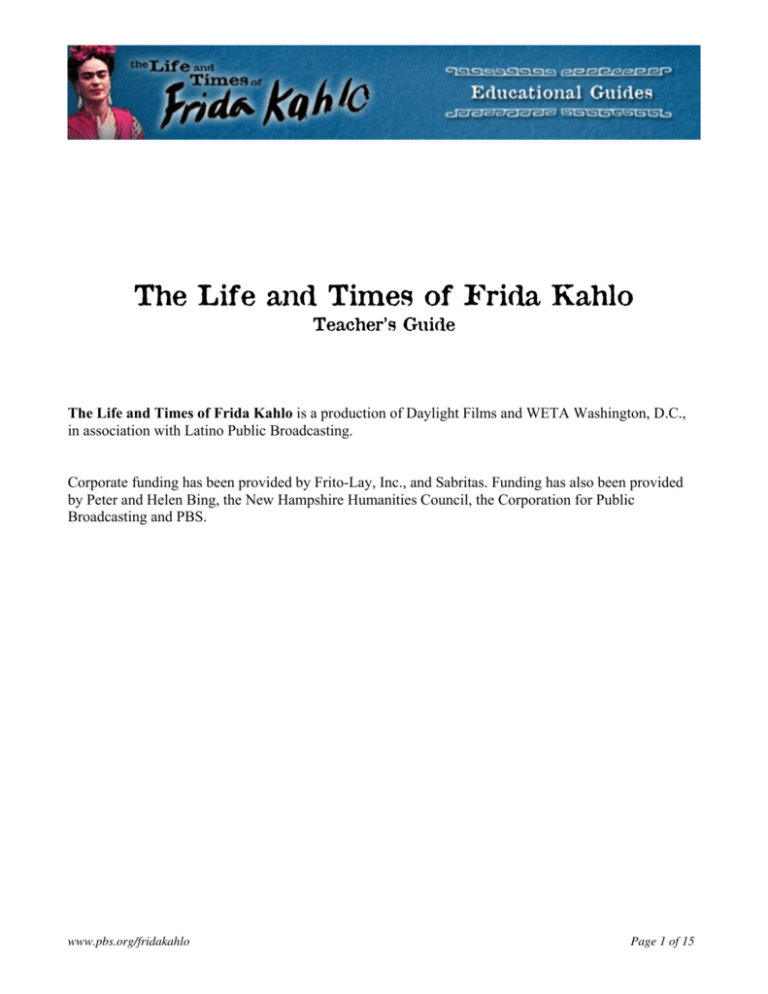
The Life and Times of Frida Kahlo Teacher’s Guide The Life and Times of Frida Kahlo is a production of Daylight Films and WETA Washington, D.C., in association with Latino Public Broadcasting. Corporate funding has been provided by Frito-Lay, Inc., and Sabritas. Funding has also been provided by Peter and Helen Bing, the New Hampshire Humanities Council, the Corporation for Public Broadcasting and PBS. www.pbs.org/fridakahlo Page 1 of 15 Introduction The following learning activities accompany the documentary The Life and Times of Frida Kahlo. Designed for 10th-12 grade language arts, social studies and art classes, the activities strengthen student understanding of Frida Kahlo’s life as well as other subjects underscored in the film, including Mexican culture and history, art movements and artistic styles. The activities can also easily be adapted for use at the college level. While exploring the artist’s personal and professional experiences, students have opportunities to extend their understanding of the topics presented — artistic expression, the influence of family, personal relationships and the value of education. The activities are designed to be used in conjunction with the program or as stand-alone lessons. If you decide to use the film, it is recommended that you preview it before showing the program to students to select segments appropriate for their viewing. You may also provide students with previewing material regarding Frida’s life. Many of the resources listed within this guide and on this Web site provide that type of information. If time permits, you can preface the viewing by discussing with students the role and value of documentaries in learning about great historic figures. As with any program that airs on PBS, we encourage teachers to determine whether The Life and Times of Frida Kahlo is appropriate for their own students. We make this recommendation because parts of the program have controversial content; because parts of the program may present concepts that are too elementary, or too difficult, for particular groups of students; or because due to time constraints, educators must select only the most relevant portions of a broadcast to use in their classrooms. www.pbs.org/fridakahlo Page 2 of 15 Lesson 1 — Artistic Expression Suggested Viewing Segments (all times are approximate) 0:00-0:05:30 introduction 0:05:30-0:09:40 childhood and family background 0:18:40-0:25:40 accident and self-portraits Objectives Students will: • • analyze Frida Kahlo’s paintings to determine how she used them for self-expression. create a personal piece of art to express sentiments on a particular subject. Introduction Invite students to share art venues/styles they use or might use to express themselves, and how they do or would reflect, for example, personal views, experiences, and emotions through their art. (The variety of art venues is expansive — poetry, music, personal essays, short stories, videos, audio recordings, painting, cartooning, computer graphics and dance are examples.) Procedure Segue into a discussion about Frida Kahlo and her use of art to express herself. Be sure students are familiar with the artist’s primary art venue, the self-portrait. Ask students to discuss what a self-portrait is, what its common characteristics are, and whether they can identify other self-portraits done by famous artists. References: The Smithsonian American Art Museum http://americanart.si.edu This site provides an interactive look at other artists’ self-portraits and collections, as well as painting and biographical information. The National Portrait Gallery of Britain http://www.npg.org.uk This site offers information about the gallery’s collections, interviews, and self-portraits and other paintings by “Creative Women in the National Portrait Gallery Collection.” Students can discuss the expressive value of this form, using references to Frida’s work. Based on the film and other resources about the artist, have students generate a list of experiences Frida references in her work. The list should include the bus accident, the loss of her baby, her physical disabilities and pain, Diego Rivera, family, friends, romantic interests, travels and her Mexican heritage. www.pbs.org/fridakahlo Page 3 of 15 Provide students with a series of Frida’s paintings that reflect the subjects they have identified. (Or students may each analyze one painting reflecting all the subjects.) Now, taking on the role of “art expert”, have students analyze the paintings in small groups or individually. In their analysis, students should identify the work’s subject; describe how Frida has represented the subject (with specific references to detail); note the time in her life when she created the piece; and determine what her feelings were when she painted the picture. Have students share and debate their impressions and as a class— identifying, for example, what was most important to her as an artist, and how she used her art to express her joys and challenges. What conclusions do they reach about Frida’s style and artistic process in relation to her life? Invite students to choose an art form and create a piece that reflects their current state of being or perspective on an issue of importance to them. Students can display their work in a classroom art show where they can explain to viewers (fellow students and teachers) the symbolism of and references in their work. Online Resources The Art of Frida Kahlo http://www.pbs.org/now/arts/frida2.html “The Art of Frida Kahlo” is explored by Julie Taymor for “NOW with Bill Moyers,” in a special section including Kahlo’s biography and an interview with Taymor. Frida by Kahlo http://www.fbuch.com/fridaby.htm The concise and informative circumstances of various selected Kahlo paintings are told on this easy to read page. Frida Kahlo Paintings http://www.fridakahlo.it/paintings.html This Web page has links to numerous different online exhibits and image galleries of Kahlo’s work throughout the years. Frida Kahlo Online http://www.artcyclopedia.com/artists/kahlo_frida.html This Artcyclopedia page consists of links to Kahlo’s paintings in museums and public galleries, art auctions, photos, biographical information, Web sites and articles. Kahlo http://cgfa.sunsite.dk/kahlo/index.html www.pbs.org/fridakahlo Page 4 of 15 This Web page offers date, medium, and gallery information for 15 different paintings, including “The Suicide of Dorothy Hale,” “What I Saw in the Water (What the Water Gave Me),” “Portrait of Eva Frederick,” and “Self-Portrait in a Velvet Dress.” Frida Kahlo: Contemporary Thoughts http://www.fridakahlo.it/ This extensive site includes the sections, Updated News, Frida’s Paintings, Frida Cult, A Brief Biography, A Few Critical Essays, The Most Complete Biography on the Web, Frida and Contemporary Arts, Exhibitions, and Friends. This main page also includes an interesting Flash movie on Kahlo. The Hammond Gallery: http://www.hammondgallery.co.uk/view_pic.php3?aid=35&pid=436 This page offers views of numerous Kahlo works, including an interactive discussion boards for each painting where users can post comments about her artwork. Standards Mid-continent Research for Education and Learning (McREL) Visual Arts 4: Understands the visual arts in relation to history and cultures 5: Understands the characteristics and merits of one's own artwork and the artwork of others World History 42: Understands major global trends from 1900 to the end of World War II Geography 4: Understands the physical and human characteristics of place 6: Understands that culture and experience influence people's perceptions of places and regions Historical Understanding 2: Understands the historical perspective Extended Activities Students can: • Study the role that education played in Frida Kahlo’s life. What aspects of her schooling indicated her future direction? What individual beliefs, attitudes, and behaviors present during her school days did she take with her into adulthood? How did she, in her later years, instruct students? Did she draw from the way she learned? • Read and analyze academic articles and essays commenting on Frida’s life and art. The Trouble with Frida Kahlo www.pbs.org/fridakahlo Page 5 of 15 http://www.washingtonmonthly.com/features/2001/0206.mencimer.html This page discusses various extraordinary sides of Frida, including her moustache, her amputations, and her sexuality. "Diego and I:" The Fiery Relationships of Frida Kahlo and Diego Rivera http://www.ksu.edu/english/janette/installations/Cecilia/kahlo.diego&I.html This page provides background on several of Kahlo’s most famous pieces, and even includes a poem by the artist. The Hidden Frida: Covert Jewish Elements in the art of Frida Kahlo http://www.hum.huji.ac.il/cja/ankori/ankori.htm This exceptionally thorough page explores the Frida Kahlo’s Jewish heritage and culture, exemplified in her personality, statements, and symbolic paintings. • Write monologues using the voice of people close to Frida (students, family members, romantic partners), speaking about their involvement with her. www.pbs.org/fridakahlo Page 6 of 15 Lesson 2 — A Likely and Unlikely Match: Frida and Diego Suggested Viewing Segments 0:00:00-0:05:30 introduction 0:28:00-0:35:00 early relationship with Diego 0:48:00-0:52:00; 0:57:00-0:59:30; 1:04:50-1:09:50 later relationship with Diego Objectives Students will: • • examine and assess the relationship between Frida Kahlo and Diego Rivera. identify how Frida Kahlo incorporates this tumultuous relationship into her artwork Procedure Share with students this statement made by Frida to a friend: "I have suffered two serious accidents in my life, one in which a streetcar ran over me ... the other accident is Diego." Have students reflect on what Frida means when she describes her relationship to Diego Rivera in this way. Have students describe the relationship between these two artists. Students may respond to the following question to guide them. • • • • • • What did Frida and Diego like and dislike about one another? How did they wish the other could be in the relationship? How did they benefit one another (emotionally, economically)? How did they harm each other? Why did they remain together despite their conflicts? Why were they unable to remain separated? Ask students to describe how the complexities of the couple’s relationship played into Frida’s art. How was the turmoil and the happiness represented? Students can analyze several paintings, including the ones located at the following links: Diego in my Thoughts http://www.honmex.com/paintings/frida_kahlo/fk001.jpg This page displays the Kahlo painting “Diego in my Thoughts.” Diego and I http://www.honmex.com/paintings/frida_kahlo/fk017.jpg This page displays the Kahlo painting “Diego and I.” Frida and Diego Rivera http://www.honmex.com/paintings/frida_kahlo/fk021.jpg This page displays the Kahlo painting “Frida and Diego Rivera.” www.pbs.org/fridakahlo Page 7 of 15 The Two Fridas http://www.artchive.com/artchive/K/kahlo/two_fridas.jpg.html This page displays the Kahlo painting “The Two Fridas.” The Love Embrace of the Universe, the Earth (Mexico), Me, and Senor Xolotl http://www.artchive.com/artchive/K/kahlo/kahlo_love_embrace.jpg.html This page displays the Kahlo painting, “The Love Embrace of the Universe, the Earth (Mexico), Me, and Senor Xolotl.” Students may then opt to create a painting that represents their perspective on the relationship between Frida and Diego, or perhaps a relationship that is influential in their lives. Students can then compare and contrast Diego and Frida’s relationship with other famous “artist couples.” This quiz introduces some famous artistic couples and is a fun way to jumpstart student research: Artistic Couples http://www.funtrivia.com/playquiz.cfm?qid=84658&origin= This page gives a 10-question page quizzing users on famous couples in the arts. The first question is about Frida Kahlo and Diego Rivera. Online Resources Frida Kahlo http://www.lasmujeres.com/fridakahlo/marriage.shtml This San Francisco Examiner Magazine article tells the “love story” of Frida Kahlo and Diego Rivera’s marriage. "Diego and I:" The Fiery Relationships of Frida Kahlo and Diego Rivera http://www.ksu.edu/english/janette/installations/Cecilia/kahlo.diego&I.html This page provides background on several of Kahlo’s most famous pieces, and even includes a poem by the artist. Marriage to Diego Rivera http://www.jlhs.nhusd.k12.ca.us/Classes/Social_Science/Latin_America/Frida%20Kahlo/marriage.html This page describes Kahlo and Rivera’s first meeting, and their subsequent marriage. Frida & Diego http://www.sandiegomag.com/issues/may00/frida.shtml This page provides some description of Frida’s accident, her painfully expressive art, and her volatile relationship with Diego. Frida Kahlo’s Gallery http://www.honmex.com/eros/frida/gallery.html This page links to many paintings by Frida Kahlo and photographs of her; titles are in English and Spanish. www.pbs.org/fridakahlo Page 8 of 15 Frida Kahlo, Diego Rivera and Twentieth-Century Mexican Art http://www.thecityreview.com/frida.html This article, by Carter B. Horsley, gives a brief art history of the two artists and the exhibits at El Museum del Barrio (2002) and the Seattle Art Museum (2003). Standards Mid-continent Research for Education and Learning (McREL) Visual Arts 4: Understands the visual arts in relation to history and cultures 5: Understands the characteristics and merits of one's own artwork and the artwork of others World History 42: Understands major global trends from 1900 to the end of World War II Geography 4: Understands the physical and human characteristics of place 6: Understands that culture and experience influence people's perceptions of places and regions Historical Understanding 2: Understands the historical perspective Extended Activities Students can: • Assess personal relationships and determine the factors that are at the core of a supportive and constructive relationship, and how that relationship remains strong. • List the many types of emotions people experience — love, fear, hate passion —and discuss under what circumstances these tend to surface in their lives. In particular, how do these emotions play out in the various relationships students have? • Write an illustrated biography about Diego Rivera. • Compare and contrast romantic relationships between other great artists. www.pbs.org/fridakahlo Page 9 of 15 Lesson 3 — Culture in Art Suggested Viewing Segments 0:00:00-0:05:30 introduction 0:09:50-0:14:30; 0:24:30-0:28:00 Mexican Revolution and early influences 0:57:00-1:01:30; 1:09:50-1:14:00 later influences and teachings Objectives Students will: • • explore how cultural aspects of their lives are depicted in society identify the cultural elements Frida Kahlo referenced in her work Introduction Ask students to define culture and then consider several definitions: "Culture taken, in its wide ethnographic sense is that complex whole which includes knowledge, belief, art, morals, law, custom, and any other capabilities and habits acquired by man as a member of society. The conditions of culture among the various societies of mankind in so far as it is capable of being investigated on general principles, is a subject apt for the study of laws of human thought and action" (Edward Burnett Tylor) Culture is "an historically transmitted pattern of meanings embodied in symbols, a system of inherited conceptions expressed in symbolic form by means of which men communicate, perpetuate, and develop their knowledge about and attitudes towards life" (Clifford Geertz) "A society's culture consists of whatever it is one has to know or believe in order to operate in a manner acceptable to its members" (Ward Goodenough) Then, have students note how elements of their culture such as youth or ethnic background figure into society and their lives. How do they, as individuals, reflect cultural elements? How are these elements reflected in society at large? How are they reflected in art, of all forms? Procedure Read or have students read the following thoughts of Victor Zamudio Taylor, a Latin American art historian and curator interviewed for the film, about Frida’s relationship and artistic representation of myriad cultural elements. “… [Frida] crosses cultural boundaries … … I think that one can say that she’s crossing boundaries between what’s considered ‘high culture’ or the fine arts from a European prospective, from a classical 19th century … start again… Frida Kahlo is also crossing boundaries within culture and within Mexican culture. Traditionally and up until the Mexican Revolution, there was the elite culture, which was mainly the culture of the Europeans and the Spaniards, and then the culture of the professionals, and then the vast culture of the Mexicans who were from rural areas, who were illiterate and who www.pbs.org/fridakahlo Page 10 of 15 had vernacular and popular traditions. When Frida Kahlo is interested in the Preparatoria and later as she’s engaged in her artwork, she bridges these different levels of Mexican culture, or these different layers of Mexican culture, so that she’s in a sense bringing together the culture of the fine arts, the culture of a European background with her love of popular Mexican culture, or rural culture, of mythic culture, the culture of healing, the culture of the marketplace, the culture of décor, the culture of attire. So one could also say that Frida Kahlo is crossing those cultural boundaries and linking them, and I think in a very sincere way. There is very little irony in the way Frida Kahlo does this. I think it’s very sincere. I think it’s from the heart, … but she knows that she has this gift and as well as privilege to make that choice. Other women did not. … So it’s not so much that the boundaries between let’s say high culture or European culture and popular Mexican culture are more flexible, they’re just more contradictory. They’re coexisting. They’re contaminating each other. They’re influencing each other.” Ask students what these statements reflect about Frida and the way she approaches the cultural influences in her life. Divide students into small groups and distribute a portfolio of Frida paintings to each group to review. (You can use the same or different pieces for each group.) Students will review them to come to conclusions about how Frida represents her heritage and culture (which, as Taylor notes, is a combination of variants). Students can use the following questions to guide their review and study. • • • • What seem to be the most important elements of Frida’s heritage? How does Frida depict these aspects of her culture in her work? How does she cross cultural boundaries and reflect combined cultural elements? What indigenous artistic influence is found in her work? How does she represent this mode? Each group should be prepared to share its thoughts using specific references to the works they have reviewed. Online Resources The Art of Frida Kahlo http://www.pbs.org/now/arts/frida2.html “The Art of Frida Kahlo” is explored by Julie Taymor for “NOW with Bill Moyers,” in a special section including Kahlo’s biography and an interview with Taymor. Frida by Kahlo http://www.fbuch.com/fridaby.htm The concise and informative circumstances of various selected Kahlo paintings are told on this easy to read page. Frida Kahlo paintings http://www.fridakahlo.it/paintings.html www.pbs.org/fridakahlo Page 11 of 15 This Web page has links to numerous different online exhibits and image galleries of Kahlo’s work throughout the years. Frida Kahlo online http://www.artcyclopedia.com/artists/kahlo_frida.html This Artcyclopedia page consists of links to Kahlo’s paintings in museums and public galleries, art auctions, photos, biographical information, Web sites and articles. Kahlo http://cgfa.sunsite.dk/kahlo/index.html This Web page offers date, medium, and gallery information for 15 different paintings, including “The Suicide of Dorothy Hale,” “What I Saw in the Water (What the Water Gave Me),” “Portrait of Eva Frederick,” and “Self-Portrait in a Velvet Dress.” Frida Kahlo paintings http://www.fantasyarts.net/Frida_Kahlo_paintings.htm This page displays selected Kahlo paintings, and contains basic information and thorough descriptions of the paintings. The Hammond Gallery: http://www.hammondgallery.co.uk/view_pic.php3?aid=35&pid=436 This page offers views of numerous Kahlo works, including an interactive discussion boards for each painting where users can post comments about her artwork. Standards Mid-continent Research for Education and Learning (McREL) Visual Arts 4: Understands the visual arts in relation to history and cultures 5: Understands the characteristics and merits of one's own artwork and the artwork of others Geography 4: Understands the physical and human characteristics of place 6: Understands that culture and experience influence people's perceptions of places and regions Historical Understanding 2: Understands the historical perspective Extended Activities Students can: • • Explore surrealism and the movement’s artists. Publish an encyclopedia of well-known 20th Century Latin American artists. www.pbs.org/fridakahlo Page 12 of 15 Discussion Questions The Life and Times of Frida Kahlo offers viewers an intimate look at the colorful and complex artist and individual. It also presents valuable insight into Mexico’s culture and history; the emergence and impact of art movements and styles (surrealism, abstraction); and the conflicting yet contiguous mix of politics, social unrest, and cross-cultural elements that influenced art and artists’ experiences during the time Frida lived and worked. The following discussion questions touch on all of these concepts. 1. What life experiences most influenced Frida Kahlo’s artwork (i.e., family, her accident, personal relationships, the Mexican Revolution, living in New York and Mexico, teaching, and her education)? 2. What were the most challenging aspects of Frida’s life? The most positive? How did these play into her artistic life? In what ways did she balance these aspects of her life? 3. Which artists and art styles inspired Frida’s paintings? How did she make her style unique, though influenced by others? 4. How did Frida’s painting style change over time? For example, when did she primarily begin to paint self-portraits? What did they typically depict? Why did Frida choose herself as the principle subject of her art? What does this choice suggest about Frida, in terms of her character, outlook on life and personal experiences? 5. What political, religious, cultural and social references are embedded in her work? To what extent was Frida committed to these elements, beyond her artistry? 6. Identify the ways Frida demonstrated her individuality (i.e., dress, artistic style, lifestyle, peers). Determine why Frida chose to present herself in these fashions (i.e., political and social statements, rebelliousness, artistic license, and personal and aesthetic style). 7. If asked what type of person Frida Kahlo was, how would you describe her? Discuss perceptions about the artist with your peers. 8. Explain the relationship between Frida and Diego and the forces that both drew them together and pulled them apart. Assess how Frida might have fared as an artist and as an individual without Diego in her life. 9. In your opinion, what largely drew attention to Frida — her artwork or lifestyle or relationships? She is now a recognized and valued artist, but during her lifetime, Frida’s paintings did not get much attention. To what do you attribute this late recognition and current popularity of her artwork? www.pbs.org/fridakahlo Page 13 of 15 Glossary Abstractionism – the theory and practice of abstract art; artistic content that depends on internal form rather than pictorial representation anarchist – an advocate of or a participant in anarchism, which is the theory or doctrine that all forms of government are oppressive and undesirable and should be abolished art nouveau – style of decoration and architecture of the late 19th and early 20th centuries, characterized particularly by the depiction of leaves and flowers in flowing, sinuous lines Aztecs – a people of central Mexico whose civilization was at its height at the time of the Spanish conquest in the early 16th century bohemian – a person with artistic or literary interests who disregards conventional standards of behavior capitalism – an economic system based on private ownership of capital communism – a form of socialism that abolishes private ownership; a political theory favoring collectivism in a classless society cubism – an artistic movement beginning in France in 1907 that featured surfaces of geometrical planes dialectical materialism –the materialistic philosophy of Karl Marx and Friedrich Engels El Greco – Greek-born Spanish painter of religious works, characterized by elongated human figures, contrasting colors, and deep shadows Fresco – the art of painting on fresh, moist plaster with pigments dissolved in water; a painting executed in this way Hieronymus Bosch – Dutch painter whose largely religious works are characterized by grotesque, fantastic creatures mingling with human figures leftist – a person believing in or supporting tenets of the political left liberal – favoring proposals for reform, open to new ideas for progress, and tolerant of the ideas and behavior of others; broad-minded Mestizo – a person of mixed racial ancestry, especially of mixed European and Native American ancestry www.pbs.org/fridakahlo Page 14 of 15 Mexican Revolution – a period of instability and civil war in Mexico which began with popular rejection of dictator Porfirio Díaz in 1910 and ended with the Institutional Revolutionary Party (PRI) in control of Mexico in the 1930s Modigliani – Italian painter and sculptor noted for the graceful elongated lines of his portraits and nudes nationalist – one who is devoted to the interests or culture of a particular nation including promoting the interests of one country over those of others Oaxaca – a city of southeastern Mexico; the provincial capital of the state of Oaxaca; inhabited chiefly by Indians radical – one who advocates fundamental or revolutionary changes in current practices, conditions, or institutions socialist – a member of a political party or group that advocates socialism; a theory or system of social reform which contemplates a complete reconstruction of society, with a more just and equitable distribution of property and labor social realism – a form of naturalistic realism focusing specifically on social problems and the hardships of everyday life surrealism – a 20th-century literary and artistic movement that attempts to express the workings of the subconscious and is characterized by fantastic imagery and incongruous juxtaposition of subject matter About the Author From classroom instructor to an executive director, Michele Israel has been an educator for nearly 20 years. She has developed and managed innovative educational initiatives, taught in nontraditional settings in the United States and overseas, developed curricula and educational materials, and designed and facilitated professional development for classroom and community educators. Her clients have included Newsweek, PBS, the Arthur Ashe Institute for Urban Health and Education World. She is currently communications manager for planned giving and endowments at the United Jewish Communities. www.pbs.org/fridakahlo Page 15 of 15
